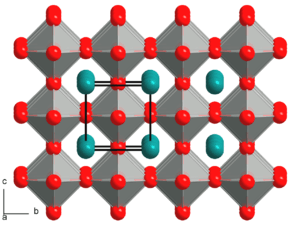Potassium niobate
Potassium niobate (KNbO3) is an inorganic compound with the formula KNbO3. A colorless solid, it is classified as a perovskite ferroelectric material. It exhibits nonlinear optical properties, and is a component of some lasers.[2] Nanowires of potassium niobate have been used to produce tunable coherent light. The LD50 for potassium niobate is 3000 mg/kg (oral, rat).
 | |
| Names | |
|---|---|
| IUPAC name
Potassium niobate | |
| Other names
niobate, niobium potassium oxide, potassium columbate | |
| Identifiers | |
3D model (JSmol) |
|
| ChemSpider | |
| ECHA InfoCard | 100.031.573 |
PubChem CID |
|
CompTox Dashboard (EPA) |
|
| |
| |
| Properties | |
| KNbO3 | |
| Molar mass | 180.003 g·mol−1 |
| Appearance | White rhombohedral crystals |
| Density | 4.640 g/cm3 |
| Melting point | ≈ 1100 °C[1] |
| Hazards | |
| Lethal dose or concentration (LD, LC): | |
LD50 (median dose) |
3000 mg/kg (oral, rat) |
Except where otherwise noted, data are given for materials in their standard state (at 25 °C [77 °F], 100 kPa). | |
| Infobox references | |
Crystal structure
On cooling from high temperature, KNbO3 undergoes a series of structural phase transitions. At 435 °C, the crystal symmetry changes from cubic centrosymmetric (Pm3m) to tetragonal non-centrosymmetric (P4mm). On further cooling, at 225 °C the crystal symmetry changes from tetragonal (P4mm) to orthorhombic (Amm2) and at −50 °C from orthorhombic (Amm2) to rhombohedral (R3m).
Use in research
Potassium niobate has been found useful in many different areas of materials science research,[3] including properties of lasers,[4] quantum teleportation,[5] and it has been used to study the optical properties of particulate composite materials.[6]
In addition to research in electronic memory storage,[3] potassium niobate is used in resonant doubling, a technique developed at the IBM Almaden Research Center.[4] This technique allows small infrared lasers to convert output into blue light, a critical technology for the production of blue lasers and technology dependent upon them.
References
- CRC Handbook, 90th Edition (03 Jun 2009) ISBN 1-4200-9084-4, section 4: Physical Constants of Inorganic Compounds, page 83
- Palik, Edward D. (1998). Handbook of Optical Constants of Solids 3. Academic Press. p. 821. ISBN 978-0-12-544423-1. Retrieved 13 December 2012.
- "In Science Fields". The Science News-Letter. 62 (17): 264–265. 1952-10-25. doi:10.2307/3931381. JSTOR 3931381. – via JSTOR (subscription required)
- Regalado, Antonio (1995-03-31). "Blue-Light Special". Science. New Series. 267 (5206): 1920. Bibcode:1995Sci...267.1920R. doi:10.1126/science.267.5206.1920. JSTOR 2886437. – via JSTOR (subscription required)
- Furusawa, A.; J. L. Sørensen; S. L. Braunstein; C. A. Fuchs; H. J. Kimble; E. S. Polzik (1998-10-23). "Unconditional Quantum Teleportation". Science. New Series. 282 (5389): 706–709. Bibcode:1998Sci...282..706F. doi:10.1126/science.282.5389.706. JSTOR 2899257. PMID 9784123. – via JSTOR (subscription required)
- Lakhtakia, Akhlesh; Tom G. Mackay (2007-02-08). "Electrical Control of the Linear Optical Properties of Particulate Composite Materials". Proceedings of the Royal Society A. 463 (2078): 583–592. arXiv:physics/0607274. Bibcode:2007RSPSA.463..583L. doi:10.1098/rspa.2006.1783. JSTOR 20209136. – via JSTOR (subscription required)